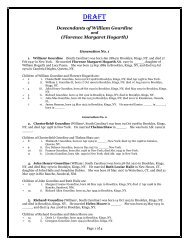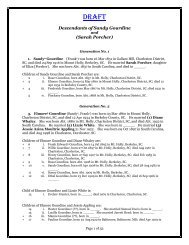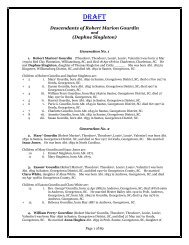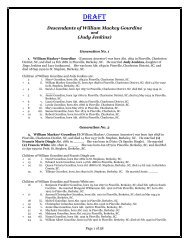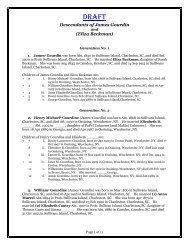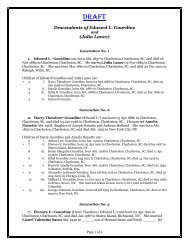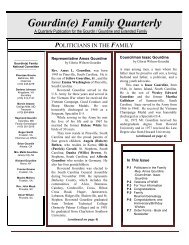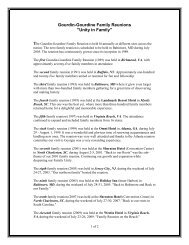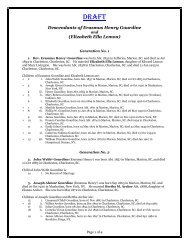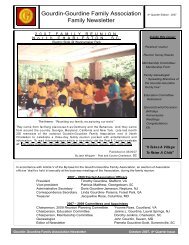Gourdin-Gourdine in America - Gourdin-Gourdine Family Association
Gourdin-Gourdine in America - Gourdin-Gourdine Family Association
Gourdin-Gourdine in America - Gourdin-Gourdine Family Association
Create successful ePaper yourself
Turn your PDF publications into a flip-book with our unique Google optimized e-Paper software.
<strong>Gourd<strong>in</strong></strong>-<strong>Gourd<strong>in</strong></strong>e <strong>in</strong> <strong>America</strong><br />
by<br />
John Raymond <strong>Gourd<strong>in</strong></strong><br />
<strong>Family</strong> Genealogist<br />
The <strong>Gourd<strong>in</strong></strong> family name has a long history <strong>in</strong> <strong>America</strong> dat<strong>in</strong>g back more than 300<br />
years. For the most part, the surname name GOURDIN arrived <strong>in</strong> <strong>America</strong> dur<strong>in</strong>g the<br />
latter part of the 17th Century when several hundred-thousand HUGUENOTS fled from<br />
France and settled <strong>in</strong> several European countries and <strong>in</strong> the English colonies of North<br />
<strong>America</strong> -- primarily Massachusetts, New York, and South Carol<strong>in</strong>a.<br />
Huguenot is a name given to Protestants of France who opposed the established religion<br />
of Catholicism dur<strong>in</strong>g the 16th and 17th Centuries. Dur<strong>in</strong>g the later part of the 16th<br />
Century, hostility between Roman Catholics and Protestants led to several religious wars.<br />
As a consequence, dur<strong>in</strong>g the 17th Century Huguenots were persecuted mercilessly, and<br />
<strong>in</strong> order to avoid annihilation they sought asylum elsewhere.<br />
Among the first Huguenots to settle <strong>in</strong> <strong>America</strong> was Louis <strong>Gourd<strong>in</strong></strong> or “Louis the<br />
Emigrant.” Louis, the son of Valent<strong>in</strong> <strong>Gourd<strong>in</strong></strong>, was born <strong>in</strong> Caucourt, Artois, France and<br />
arrived <strong>in</strong> <strong>America</strong> about 1695, then settled near the city of Jamestown <strong>in</strong> an area called<br />
the French/Orange Quarters -- now the counties of Berkeley and Charleston, South<br />
Carol<strong>in</strong>a.<br />
The <strong>Gourd<strong>in</strong></strong> family saw moderate success dur<strong>in</strong>g the Colonial period <strong>in</strong> <strong>America</strong> but<br />
prospered substantially after the <strong>America</strong>n Revolution. After <strong>America</strong> became a nation <strong>in</strong><br />
1789 the <strong>Gourd<strong>in</strong></strong> family cont<strong>in</strong>ued to develop status and wealth, especially dur<strong>in</strong>g the<br />
first half of the 19th Century preced<strong>in</strong>g the Civil War. Theodore <strong>Gourd<strong>in</strong></strong>, the great-greatgrandson<br />
of Louis the Emigrant, is generally credited with the f<strong>in</strong>ancial successes of the<br />
<strong>Gourd<strong>in</strong></strong> family.<br />
Dur<strong>in</strong>g the first two decades of 1800, the <strong>Gourd<strong>in</strong></strong> family amassed an empire primarily <strong>in</strong><br />
the counties of Berkeley, Charleston, Georgetown and Williamsburg accumulat<strong>in</strong>g more<br />
than 100,000 acres of land and nearly 600 slaves. But the Civil War and the<br />
Emancipation Proclamation brought that empire to an end.<br />
Dur<strong>in</strong>g the 10 to 15 years follow<strong>in</strong>g the Civil War, or the Era of Reconstruction <strong>in</strong><br />
<strong>America</strong>, the <strong>Gourd<strong>in</strong></strong> family fortune crumbled due to the end of free slave labor and the<br />
<strong>in</strong>stitution of the sharecropp<strong>in</strong>g system. The once grand plantations and plantation houses<br />
fell <strong>in</strong>to default and decay, and by 1905, practically all of the <strong>Gourd<strong>in</strong></strong> family properties<br />
were sold or auctioned off to the highest bidders with the exception of the personal<br />
hold<strong>in</strong>g of the rema<strong>in</strong><strong>in</strong>g descendants of the <strong>Gourd<strong>in</strong></strong> empire.<br />
For the most part, the surname GOURDINE, <strong>in</strong> <strong>America</strong>, emerged from the surname<br />
<strong>Gourd<strong>in</strong></strong> dur<strong>in</strong>g the mid- to late-1800s as Afro-<strong>Gourd<strong>in</strong></strong>s from South Carol<strong>in</strong>a began<br />
migrat<strong>in</strong>g northwardly and added an “e” to their names for reasons yet to be<br />
substantiated. As a result, <strong>in</strong> <strong>America</strong>, the surname <strong>Gourd<strong>in</strong></strong>e is almost uniquely, but not<br />
entirely, associated with African-<strong>America</strong>ns; while the surname <strong>Gourd<strong>in</strong></strong> is closely<br />
1 of 2
<strong>Gourd<strong>in</strong></strong>-<strong>Gourd<strong>in</strong></strong>e<br />
(cont’d)<br />
aligned with European-<strong>America</strong>ns, however, both surnames can be found, at least<br />
sparsely, among several races and nationalities from a variety of locations.<br />
In <strong>America</strong>, some <strong>Gourd<strong>in</strong></strong>s and <strong>Gourd<strong>in</strong></strong>es, of African Descent, are direct descendants of<br />
Louis the Emigrant, while others systematically adopted the surname from their former<br />
owners after the Civil War. Although the surnames of <strong>Gourd<strong>in</strong></strong> and <strong>Gourd<strong>in</strong></strong>e <strong>in</strong> <strong>America</strong><br />
are explicitly tied to the Louis the Emigrant, this connection is not unique to the <strong>Gourd<strong>in</strong></strong><br />
family orig<strong>in</strong>.<br />
There are other <strong>Gourd<strong>in</strong></strong> families <strong>in</strong> <strong>America</strong>. Their orig<strong>in</strong>s are both European and South<br />
<strong>America</strong>n who appear to have arrived <strong>in</strong> <strong>America</strong> dur<strong>in</strong>g the late 19th and early 20th<br />
Century. Likewise, there are a number of Euro-<strong>America</strong>n <strong>Gourd<strong>in</strong></strong>es sparsely populated<br />
here and about <strong>in</strong> <strong>America</strong> who, for the most part, arrived <strong>in</strong> <strong>America</strong> through a<br />
circuitous route. They are primarily Belgians who first settled <strong>in</strong> Canada under the name<br />
of <strong>Gourd<strong>in</strong></strong>ne, then further traveled to <strong>America</strong> and dropped the second “n” to become<br />
<strong>Gourd<strong>in</strong></strong>e.<br />
So we are not alone. While the <strong>Gourd<strong>in</strong></strong>-<strong>Gourd<strong>in</strong></strong>e <strong>Family</strong> <strong>Association</strong> is primarily<br />
focused on families and <strong>in</strong>dividuals of African Descent, our membership rema<strong>in</strong>s open to<br />
anyone who shares an <strong>in</strong>terest <strong>in</strong> explor<strong>in</strong>g the history and genealogy of <strong>Gourd<strong>in</strong></strong>s and<br />
<strong>Gourd<strong>in</strong></strong>es <strong>in</strong> <strong>America</strong>.<br />
EXCERPT: <strong>Gourd<strong>in</strong></strong>-<strong>Gourd<strong>in</strong></strong>e Quarterly Newsletter<br />
2 of 2




